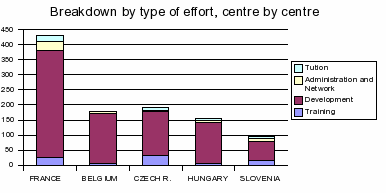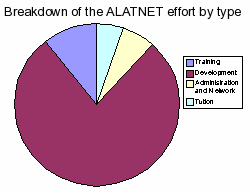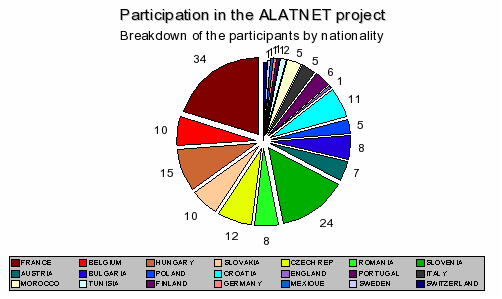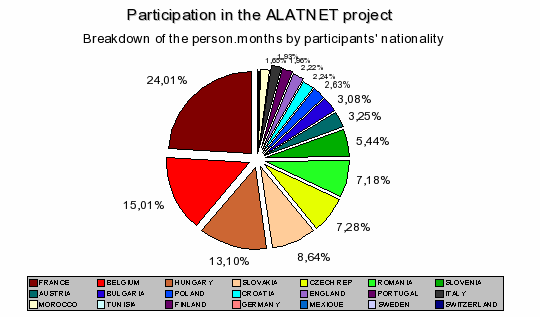

There were no significant changes this year (see Part B4.4 hereafter for all details about the network’s management and achievements in terms of cross-visits, organised events and communication). Just some delay happened in the publication of the Newsletters, the size of which keeps increasing. The latest one, covering the first 6 months of 2003, is available only on-line, via the ALATNET and ALADIN web sites. The last one will be finalized after the present reports.
Let us recall the numbering of the involved research centres :
1
Toulouse (Fr) 2 Brussels (Be) 3 Prague
(Cz) 4 Budapest (Hu) 5 Ljubljana (Si)
place and date : Ljubljana (Si), 24 March 2003
program : preparation of the final workshop, financial matters, revision of the work plan, future strategical issues, …
summary on the ALATNET web site
place and date : Szokolya-Kiralyret (Hu), 15-17 October 2003
objectives and organization :
The last big ALATNET event was organized in Kiralyret (70 km North from Budapest) in Hungary on 15-17 October, 2003.
The idea of the seminar was born during the mid-term review in Brussels (April, 2002). The main objective of the workshop was to give a last opportunity to the young researchers to meet and present their work before the end of the project. The occasion was also used to discuss potential continuation possibilities of such a research and training network.
Beside the young researchers, their supervisors and ALATNET coordinators, also each SRNWP consortium obtained an invitation to the seminar. Finally the SRNWP coordinator (Jean Quiby), the HIRLAM Project Leader (Per Unden) and a representative of the UK Met' Office (Nigel Wood) accepted the invitation and took part in the meeting. Altogether 39 participants from 14 countries attended the event.
The first part of the meeting was devoted to the presentations of the young researchers (30 minutes time was allocated to each presentation and 15 minutes to the discussions afterwards, in order not to be bounded by time limitations for the speeches and discussions). After the presentations of the young researchers, a session was organized for the presentation of the training activities at each SRNWP consortium in Europe. These presentations and discussions prepared the "ground" for the discussion on a possible "continuation" of the ALATNET project. The main idea is to extend the concept to a truly European network involving all the SRNWP consortia. It was decided that in 2004 such a bid to the 6th FP of EU will be submitted and that the first draft of the preparatory documents will be prepared by Météo-France, owing to its coordination experience acquired in ALATNET.
The details of the seminar together with the presentations and
articles in the proceedings can be accessed from the ALATNET homepage
or directly from the homepage of the Hungarian Meteorological Service
:
http://omsz.met.hu/ismeretterjesztes/rendezvenyek/alatnet2003/alatnet.php
place and date : Budapest (Hu), 20-22 October 2003
aim : taking benefit of the presence of experts coming for the last ALATNET seminar to organize discussions around data assimilation issues.
participants : S. Alexandru (Ro), T. Auligné (Fr), G.P. Balsamo (It), M. Belo-Pereira (Pt), L. Berre (Fr), G. Bölöni (Hu), R. Brozkova (Cz), G. Csima (Hu), A. Deckmyn (Be), C. Fischer (Fr), A. Horanyi (Hu), K. Horvath (Hr), S. Ivatek-Sahdan (Hr), M. Jurasek (Sk), S. Kertesz (Hu), D. Klaric (Hr), K. Kullmann (Hu), O. Latinne (Be), G. Radnoti (Hu), R. Randriamampianina (Hu), C. Soci (Ro), S. Stefanescu (Ro), H. Toth (Hu), F. Wimmer (At), R. Szotak (Hu).
place and date : Prague (Cz), 13 February 2004
program : preparation of the final report
summary on the ALATNET web site
Toulouse Brussels
Toulouse Prague
|
J.-F. Geleyn, |
01/09/2003 - 30/10/2003 |
: physical parameterizations, coordination |
|
J.-F. Geleyn, |
24/11/2003 - 13/02/2004 |
: physical parameterizations, coordination |
|
Y. Bouteloup, |
24/11/2003 - 28/11/2003 |
: scientific coordination |
|
F. Bouyssel, |
24/11/2003 - 28/11/2003 |
: scientific coordination |
|
C. Fischer, |
24/11/2003 - 28/11/2003 |
: scientific coordination |
|
P. Pottier, |
24/11/2003 - 28/11/2003 |
: coordination |
|
D. Giard, |
12/02/2004 - 13/02/2004 |
: coordination |
|
P. Pottier, |
12/02/2004 - 13/02/2004 |
: coordination |
|
C. Fischer, |
12/02/2004 - 13/02/2004 |
: coordination |
|
G. Hello, |
12/02/2004 - 13/02/2004 |
: coordination |
|
F. Bouttier, |
13/02/2004 |
: coordination |
Toulouse Budapest
|
T. Auligné, |
20/10/2003 - 22/10/2003 |
: mini-workshop on data assimilation |
|
G.P. Balsamo, |
20/10/2003 - 22/10/2003 |
: mini-workshop on data assimilation |
|
M. Belo-Pereira, |
20/10/2003 - 22/10/2003 |
: mini-workshop on data assimilation |
|
L. Berre, |
20/10/2003 - 22/10/2003 |
: mini-workshop on data assimilation |
|
C. Fischer, |
20/10/2003 - 22/10/2003 |
: mini-workshop on data assimilation |
Toulouse Ljubljana
|
J.-F. Geleyn, |
24/03/2003 |
: coordination |
|
D. Giard, |
24/03/2003 |
: coordination |
Brussels Toulouse
|
P. Termonia, |
31/03/2003 - 22/05/2003 |
: coupling |
|
O. Latinne, |
19/06/2003 - 04/07/2003 |
: improved description of surface |
|
A. Deckmyn, |
01/09/2003 - 20/09/2003 |
: background error description |
|
C. Moussy, |
15/09/2003 - 31/10/2003 |
: coupling |
|
B. Catry, |
17/11/2003 - 28/11/2003 |
: orographic forcing |
|
O. Latinne, |
10/12/2003 - 20/12/2003 |
: improved description of surface |
|
P. Termonia, |
16/02/2004 - 23/02/2004 |
: physics-dynamics interface |
Brussels Prague
|
L. Gerard, |
24/11/2003 - 28/11/2003 |
: scientific coordination |
|
C. Moussy, |
24/11/2003 - 28/11/2003 |
: scientific coordination |
|
P. Termonia, |
24/11/2003 - 28/11/2003 |
: scientific coordination |
|
J. Vanderborght, |
12/02/2004 |
: coordination |
|
L. Gerard, |
13/02/2004 |
: coordination |
Brussels Budapest
|
A. Deckmyn, |
20/10/2003 - 22/10/2003 |
: mini-workshop on data assimilation |
|
O. Latinne, |
20/10/2003 - 22/10/2003 |
: mini-workshop on data assimilation |
Brussels Ljubljana
|
J. Vanderborght, |
24/03/2003 |
: coordination |
Prague Toulouse
|
F. Vana, |
02/03/2003 - 13/04/2003 |
: noise problems in dynamics |
|
R. Brozkova, |
01/04/2003 - 21/04/2003 |
: lower boundary condition in NH dynamics |
|
M. Janousek, |
16/08/2003 - 30/09/2003 |
: radiative upper boundary condition |
|
A. Trojakova, |
01/10/2003 - 15/11/2003 |
: thermal forcing and NH dynamics |
|
F. Vana, |
13/12/2003 - 20/12/2003 |
: noise problems in dynamics |
|
A. Trojakova, |
01/02/2004 - 29/02/2004 |
: thermal forcing and NH dynamics |
Prague Brussels
Prague Budapest
|
R. Brozkova, |
20/10/2003 - 22/10/2003 |
: mini-workshop on data assimilation |
Prague Ljubljana
|
M. Janousek, |
24/03/2003 |
: coordination |
Budapest Toulouse
|
L. Kullmann, |
01/05/2003 - 31/07/2003 |
: physics-dynamics interface |
|
G. Radnoti, |
01/09/2003 - 15/10/2003 |
: coupling |
|
G. Bölöni, |
01/02/2004 - 14/03/2004 |
: data assimilation |
Budapest Prague
|
H. Toth, |
06/07/2003 - 05/09/2003 |
: data assimilation and blending |
|
G. Bölöni, |
24/11/2003 - 28/11/2003 |
: scientific coordination |
|
G. Radnoti, |
24/11/2003 - 28/11/2003 |
: scientific coordination |
|
A. Horanyi, |
12/02/2004 - 13/02/2004 |
: coordination |
Budapest Ljubljana
|
A. Horanyi, |
24/03/2003 |
: coordination |
Ljubljana Toulouse
|
J. Cedilnik, |
04/01/2004 - 14/02/2004 |
: orographic forcing |
Ljubljana Brussels
Ljubljana Prague
|
J. Cedilnik, |
24/11/2003 - 28/11/2003 |
: scientific coordination |
|
J. Jerman, |
24/11/2003 - 28/11/2003 |
: scientific coordination |
|
M. Razinger, |
24/11/2003 - 28/11/2003 |
: scientific coordination |
|
G. Skok, |
24/11/2003 - 28/11/2003 |
: scientific coordination |
|
N. Pristov, |
19/01/2004 - 30/01/2004 |
: radiation |
Ljubljana Budapest
25th EWGLAM and 10th SRNWP meetings (Lisbon, Portugal, 6-9/10/2003),
with the participation of :
- M. Belo-Pereira, E. Gérard,
D. Giard, V. Guidard, A. Simon (P1),
- J.
Vanderborght (P2),
- F. Vana (P3),
- G. Bölöni,
A. Horanyi (P4),
- N. Pristov (P5).
5th SRNWP workshop on non-hydrostatic modelling (Bad Orb, Germany,
27-29/10/2003) :
- P. Bénard, S. Malardel (P1),
-
R. Brozkova, J. Vivoda (P3).
13th ALADIN workshop (Prague, 24-28/11/2003), attended by the
following ALATNET young researchers (and several scientists from the
five centres, see hereabove) :
- J.
Vivoda (P3),
- K. Stadlbacher (P5).
It is simpler than initially scheduled. The supervision of the ALATNET project is performed by a steering committee composed of 8 members (5 women, 3 men) :
P1 : Jean-François Geleyn (project coordinator), Patricia Pottier (project secretary), Dominique Giard (French coordinator),
P2 : Josette Vanderborght (Belgian coordinator),
P3 : Radmila Brozkova (Czech coordinator),
P4 : Andras Horanyi (Hungarian coordinator),
P5 : Jure Jerman and Neva Pristov (Slovenian coordinators).
The steering committee is responsible for the overall project management : recruitment of the young researchers, training issues, communication, monitoring of the research plan, financial problems, reports, etc. It meets at least once a year (see hereafter). In-between e-mail communication is at the root of the network's life.
For scientific issues, it receives help from the other thematic ALADIN coordinators members of the ALATNET teams : P. Bénard, F. Bouyssel, C. Fischer and E. Gérard in Toulouse, L. Gerard in Brussels, P. Smolikova in Prague, G. Bölöni and G. Radnoti in Budapest.
The organization of the network events was shared equally between the five partners (with each time support from the other teams of course) :
ALATNET seminars in Czech Republic (2000), France (2001), Slovenia (2002) and Hungary (2003), mid-term review in Belgium (2002).
Teachers for the training courses came from the 5 ALATNET teams.
Meetings of the steering committee were successively held in Toulouse (1st, 2000), Brussels (2nd, 2001), Budapest (4th, 2002), Ljubljana (6th, 2003) and Prague (7th, 2004); the 3rd and 5th official ones were organized beside other events, as were the 4 informal coordination meetings.
A dedicated database is maintained in Toulouse, that allows to trace-back any work undertaken for ALATNET and/or under ALATNET financing and evaluate the partition of efforts, between partners and between the various duties of such a network (development with some declinations, training, tutorial/teaching/communication, coordination/administration). It is regularly updated and revalidated, every three months, which allows a fine-tuned supervision of the network.
An ALATNET web site was created and updated regularly
:
http://www.cnrm.meteo.fr/alatnet/
It provides informations on ALATNET events, young researchers, coordinators, progress of the research plan, training courses, ... and is linked to the web sites of the European Commission and of the ALADIN project (hence to the web pages of the ALATNET partners). A specific ALATNET e-mail list (now including 37 addresses) was created for exchanges between students, mentors, and coordinators : alatnet@meteo.fr. The young researchers may also use the other ALADIN diffusion lists of course.
An ALATNET Newsletter is published every 6 months, jointly with the ALADIN Newsletter. There is a clear distinction between contributions but they are edited together, to provide the young researchers an overview of the more general research around ALADIN and to make their results known by a large scientific community. The Newsletters are available on the ALATNET and ALADIN web sites and sent to all ALADIN partners and to representatives of the four European SRNWP consortia.
All young researchers had the opportunity to meet other young scientists during the 4 ALATNET seminars, the last one being dedicated to such a purpose. Most of them attended an ALADIN or a wider European workshop during their employment, and as far as possible presented their work there. Only Raluca Radu couldn't benefit from such an opportunity, since she started late and such events didn't correspond to periods of employment in Ljubljana. On the other hand, Steluta Alexandru attended an international meeting in Japan, and Malgorzata Szczech another one in Canada along the last year of the project.
Besides this advertising at the European level about ALATNET seminars and results, publicity was made within the ALADIN group presentation at all annual joint EWGLAM - SRNWP meetings, and via the young researchers' ones at international workshops, i.e. at least once or twice a year. The significant advances in ALATNET research topics along the last four years , and the associated publications as well as the impact on operational suites, also contributed to promote the project, but more towards its end.
To end with, official invitations to the ALATNET seminars were sent each time to the other SRNWP consortia, hence to all European NMSs.
First steps
Young researchers
Seminars and workshops
Coordination meetings
Exchanges with the Commission
|
from to |
|
Toulouse |
Brussels |
Prague |
Budapest |
Ljubljana |
sent |
|
Toulouse |
1. 2. 3. 4. sum |
|
1 6
7 |
1 1 11 13 |
1
3 5 (2) 9 |
1 2 3 |
32 (2) |
|
Brussels |
1. 2. 3. 4. sum |
5 6 (1) 3 7 21 |
|
5 5 |
2 2 4 |
2 1 3 |
33(1) |
|
Prague |
1. 2. 3. 4. sum |
5 6 8 (2) 6 25 |
1
1 |
|
1
2 1 4 |
1 1 2 |
32 (2) |
|
Budapest |
1. 2. 3. 4. sum |
8 6 3 3 21 |
1
1 |
3 3 4 4 14 |
|
1
1 1 3 |
39 (0) |
|
Ljubljana |
1. 2. 3. 4. sum |
2 6 (1) 2 1 11 |
1
1 |
4 4 (1) 4 5 17 |
1
3 (1)
4 |
|
33 (3) |
|
received |
|
78 (4) |
10 (0) |
49 (1) |
21 (3) |
11 (0) |
169 |
Concerning the manpower target, the contract commitment was 1055 person×months while the figure diagnosed from the project database on all ALATNET related actions gives 1047.5 person×months, i.e. only a slight deviation from the initial objectives (by -0.7%). The proportion of work accomplished by women reaches 28% (and even 31% for young researchers, see Parts B.3 and B.5 for more details) and the part of the young researchers 22%. The partition between the five centres is detailed hereafter.
Professional research effort on the network project after 4 years
|
|
Young researchers' effort, |
Researchers' effort, |
||||||
|
|
initial target |
revised target |
realisation |
rate |
initial target |
revised target |
realisation |
rate |
|
1 |
78 |
78 |
78 |
1.00 |
283 |
348 |
349.75 |
1.01 |
|
2 |
38 |
38 |
38 |
1.00 |
136 |
114 |
142.00 |
1.25 |
|
3 |
46 |
46 |
46 |
1.00 |
173 |
173 |
145.75 |
0.84 |
|
4 |
24 |
28 |
28 |
1.00 |
106 |
102 |
125.75 |
1.23 |
|
5 |
38 |
41 |
41 |
1.00 |
133 |
87 |
53.25 |
0.61 |
|
total |
224 |
231 |
231 |
1.00 |
831 |
824 |
816.50 |
0.99 |
|
Partner |
Total research and training effort |
Number of researchers involved |
|||||
|
|
initial target |
revised target |
realisation |
rates |
initial target |
revised target |
realisation |
|
1 |
361 |
426 |
427.75 |
1.18 / 1.00 |
17 |
17 |
24 |
|
2 |
174 |
152 |
180.00 |
1.03 / 1.18 |
9 |
9 |
7 |
|
3 |
219 |
219 |
191.75 |
0.88 / 0.88 |
12 |
12 |
9 |
|
4 |
130 |
130 |
153.75 |
1.18 / 1.18 |
7 |
7 |
9 |
|
5 |
171 |
128 |
94.25 |
0.55 / 0.74 |
7 |
7 |
5 |
|
total |
1055 |
1055 |
1047.5 |
0.99 / 0.99 |
52 |
52 |
54 |
Part of the research effort in the project


In support to the claim that the ALATNET work has been a true networking one, it must be pointed out that 43% of the work was accomplished by non-nationals of the place of work, with a breakdown of 100% for young researchers (of course) but also of 26% for other people, this showing a high level of cross mobility. These figures are to be compared to the background ALADIN mobility : 32% of the effort realised through research-training stays outside the 15 home institutions, this corresponding to 15% of the total cost of the project (salaries, telecommunication and computing costs included) and a sustained effort of 50 equivalent-persons. The situation was not that bad, but ALATNET further improved it. The five centres didn't equally benefit from such exchanges, as illustrated by the above table of cross-visits and the diagram hereafter.

In terms of the networking contribution to scientific achievements, four cases can be distinguished. The four most successful parts of the programme (Items 1, 2, 6 and 11, see Part A.1 for details) were solved only thanks a true interactive sharing of responsibilities which could not have been possible without the EU financing of networking activities and, especially in case of Item 1, the anchoring role of the young researchers' recruitment. Some other topics (Items 8 and 9), even if a bit less successful, witnessed some interesting progress owing to the critical mass brought in by the necessity and willingness to involve many contributions, this being in turn made possible by the ALATNET financing. On the contrary, there were subjects (Items 3, 4 and 12) where specialisation was crucial and that were tackled in unilateral or bilateral mode, the benefit of the EU support being mainly the possibility of recruiting young researchers, especially in case of Item 12. Finally there were three Items (5, 7 and 10) that were rather transversal and also benefited from one young researcher's additional workforce but where things unfortunately never really aggregated to a common momentum.
The impact of the networking activities on the training can best be judged from the above tables and from the details given in Part B5. Concerning the benefits of the work between EU and accessing states, the ALATNET results cannot be disconnected from the ALADIN ones (15 participant countries, out of which 4 EU ones and 7 accessing ones). The wide participation to ALATNET activities at the European level is illustrated by the two following diagrams :


As mentioned at the end of Part A.1, the ALATNET effort was decisive in the current possibility to see a pan-European enlargement of the ALADIN NWP activities. On the four-year average corresponding to the network’s life, the ALATNET- bound effort (directly and indirectly financed) represents a stable 43% of the scientific ALADIN activity (for 6% of direct EU financing, with reference to a budget including all activities: training, research, computing and telecommunication). These figures best show the catalytic effect that the ALATNET EU-support had on the ALADIN project. But, on the other hand, without the backbone of the ALADIN structure, ALATNET could not have the ambitions that were set to it and, for the most part, fulfilled.
B-